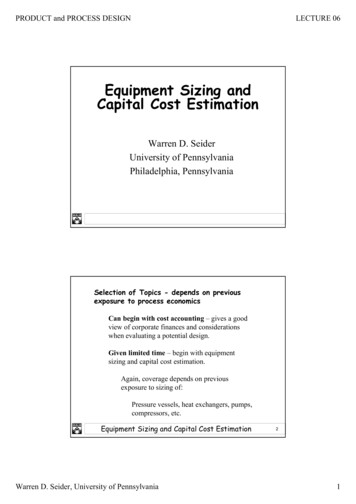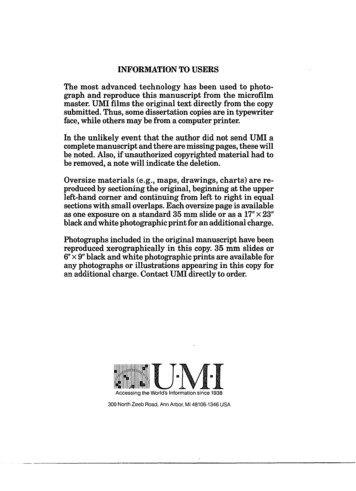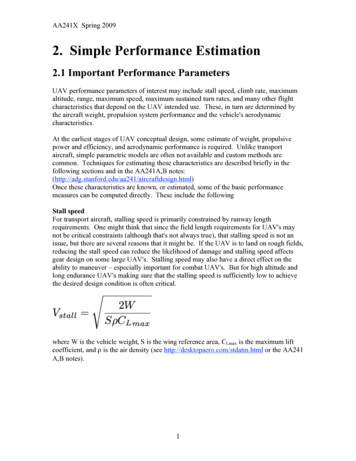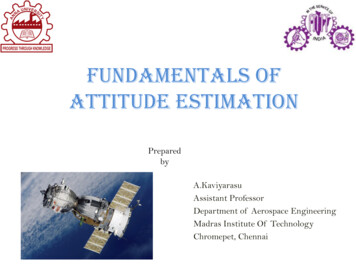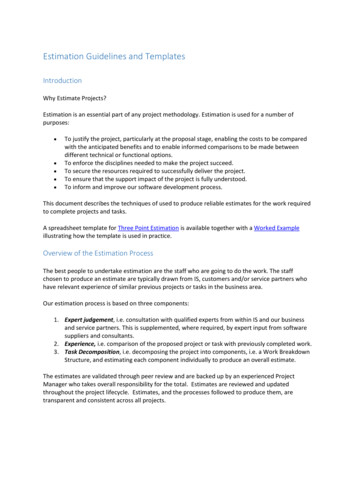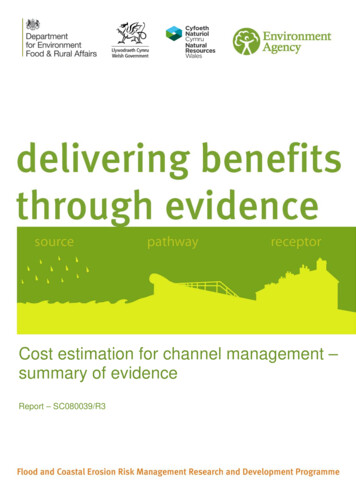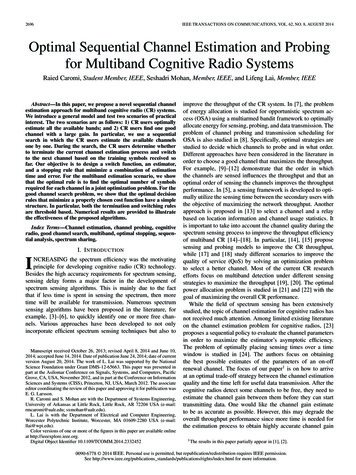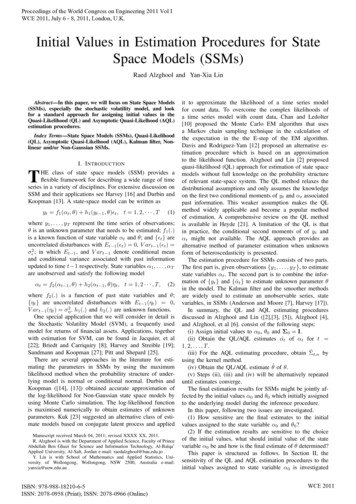
Transcription
BULETINUL INSTITUTULUI POLITEHNIC DIN IAŞIPublicat deUniversitatea Tehnică „Gheorghe Asachi” din IaşiTomul LVI (LX), Fasc. 1, 2010SecţiaCONSTRUCŢII. ĂRHITECTURĂTHE ROLE OF ESTIMATION ON CONSTRUCTION LIFECYCLEBYEDUARD ANTOHIEAbstract. Estimates serve a number of different functions in the constructionindustry. The reason for estimating is to provide the most realistic prediction possible oftime and cost at any given stage in a project. Over the life of a project the estimatorshould be able to produce a series of estimates, from an early estimate at beginning, to thefinal account, in which the increasing accuracy of the estimate is reflected in thedecreasing extent of risk and uncertainty. All estimates take the form of base estimates,plus allowances for uncertainties and specific contingencies as required. The role of theestimator or practitioner in cost engineering is vital to the success of a constructionproject. The estimators are responsible for predicting the most economic costs forconstruction in a way that is both clear and consistent. Although an estimator will have afeel for the prices in the marketplace, it is the responsibility of management to add anamount for general overheads, assess the risks and turn the estimate into tender.Key words: cost estimate; estimator; cost engineering; cost construction life cycle;cost management.1. IntroductionThe estimated cost means an estimate of the final total cost of executionof a construction project. This definition requires two important issues, namelya) the estimate is an approximate calculation;b) estimate contains uncertainties.
28Eduard AntohieMain purpose of estimating costs is to provide a size reference for costcontrol, to verify that the resources consumed during the execution of theproject are kept in the costs assessed in feasibility phase of the project.Deviations from these issues can endanger the profitability of the project and asuccessful project can turn into a disaster. Accuracy of estimates of costdepends on existing information to reflect and their calculation. In Fig. 1 isshown a structure of total costs of a construction project in this regard.Fig. 1 – Components of life cycle costs.There are several ways of classifying types of estimates of the costs of aconstruction project. Of these, the most significant are the followings:a) Estimates that depend on the degree of definition of the project.Such estimates depend on the rate of breakdown of the architectural design andstrength. Are defined as the level of information they have available thepractitioner to perform engineering cost estimates.b) Estimates that depend on their use. Such estimates are directlyrelated to the utility for which they are made. Thus we have estimates used forthe preparation of feasibility studies, estimates for preparing documentationauthorizing the work, estimates for budget planning, estimates for thepreparation of the contractors bid price, estimates for the aforementionedproject, etc.c) The methodology to estimate. To estimate costs using severalmethodologies, training and procedures that estimate the costs, which in turncan be probabilistic or deterministic in nature.
Bul. Inst. Polit. Iaşi, t. LVI (LX), f. 1, 2010292. Types of Cost EstimatesDuring the life cycle of a project are made different estimates. Theseestimates are used for the various functions of project management. (s. Fig. 2).Fig. 2 – Costs estimates during construction life cycle.
30Eduard AntohieThus in an early stage of development of the construction project, therecipient needs an estimate of the likely cost of the project (investment) toassess the financial feasibility of its. This estimate is made available having aminimum volume of information as is required time when the investor has avague idea of what wants to do. Once the design is started you can makeestimates of the budgets of the various stages of project implementation. Thesebudgets are grouped in a cost plan which is a summary of all project costs forconstruction. The size of this budget is checked periodically during the detaildesign, using the method of estimation of increasingly accurate with the designdetails of implementation. Also, in the initial budget period to undergo, changesand corrections are aiming to stick to the costs adopted in the content of thefeasibility study. In case of correlation, are estimates for design alternatives.Finally, estimates are used to anticipate and analyse beneficiary bids. Estimatesare also made after the start of actual implementation of the project, for costcontrol. Contractors made estimates of the maximum cost of their activities insuch a way that with the amounts offered and contracted. Duringimplementation estimated actual cost of works carried out, comparing themwith limited costs and made the necessary corrections. Also during theexecution, beneficiary estimate prices for the changes requested in the projectand analyse their impact to the feasibility study and initial contract execution.3. Role of Estimating in the Construction IndustryEstimates serve a number of different functions in the constructionindustry (s. Fig. 3). In the early stages of a construction program, the ownerneeds an estimate of the probable cost of construction. This conceptual estimatehas to be prepared from a minimum amount of information because it isrequired at a time when the project is often little more than a vague idea in themind of the owner. Once the design of the project is underway, budget amountscan be established for the various elements of the project. When the design iscompleted, a final pre-bid estimate can be compiled to anticipate thecontractor’s bid price for work. If this estimates is accurate, the obtained bidprices will be within the owner’s budget for the project. Most contracts thattranspire in the construction industry results from competing bids fromcontractors to suplly goods and services to meet certain specification for astipulated sum of money. Estimates are also required after works starts on theproject. In the cost control programs, estimating is required to facilitate thecontrol of expenditure of founds on a project.
Bul. Inst. Polit. Iaşi, t. LVI (LX), f. 1, 201031Fig. 3 – Role of the estimator of construction costs.4. ConclusionsEstimating serves a number of purposes in the construction processincluding preparation of bids and cost control. The role of the estimator includespreparing conceptual estimates, preliminary estimates, pre-bid estimates, postbid estimates, cost control, final project cost, cost on the operating constructionperiod and cost of remodeling or demolition of the construction.Received, October 28, 2009„Gheorghe Asachi” Technical University of Iaşi,Department of Concrete, Materials,Technology and Managemente-mail: eantohie@yahoo.comREFERENCES1. Brook M., Estimating and Tandering for Construction Work. Butterworth-Heinemann, Oxford, UK, 2008.
32Eduard Antohie2. Venkataraman R., Pinto J., Cost and Value Management in Projects. John Wiley a.Sons, Inc., Hoboken, New Jersey, 2008.3. Antohie E., Economia Construcţiilor. Edit. Acad. „Teiu Botez”, Iaşi, 2009.ROLUL ESTIMĂRILOR PE PERIOADA DE VIAŢĂ A UNUI PROIECT DECONSTRUCŢIE(Rezumat)Estimările sunt utilizate pentru funcţii diferite în industria construcţiilor.Motivul pentru estimare este cel de a oferi cea mai realistă predicţie în termeni de timpşi cost în orice etapă a unui proiect. Pe durata de viaţă a unui proiect estimatorul artrebui să fie în măsură să producă o serie de estimări, de la o estimare anticipată laînceput, la estimarea finală la terminarea proiectului, în care precizia tot mai mare deestimare este reflectată în scăderea riscului şi incertitudinilor. Rolul estimatorului saupracticianului în ingineria costurilor este vital pentru succesul unui proiect deconstrucţie. Estimatorii sunt responsabili pentru estimarea costurilor într-un mod clar şilimpede. În ce priveşte realizarea costurilor şi încadrarea în cheltuielile cuprinse înstudiul de fezabilitate, responsabilitatea este a managerilor de proiect. Se face o trecereîn revistă a diferitelor tipuri de evaluări ce pot apare pe perioada de viaţă a uneiconstrucţii, evidenţiind rolul estimatorului sau a practicianului în ingineria costurilor însuccesul unui proiect de construcţie.
needs an estimate of the probable cost of construction. This conceptual estimate has to be prepared from a minimum amount of information because it is required at a time when the project is often little more than a vague idea in the mind of the owner. Once the design of the project is underway, budget amounts can be established for the various elements of the project. When the design is .

